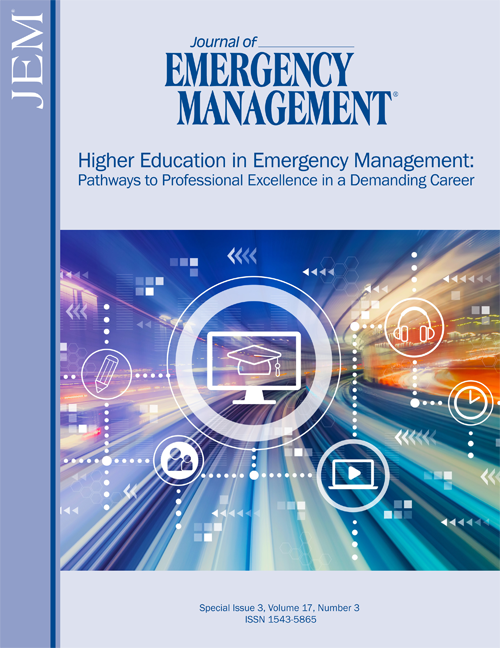Ensuring a competent public health responder workforce: The CDC experience
DOI:
https://doi.org/10.5055/jem.2019.0418Keywords:
needs assessment, education and training, public health preparedness, public health professionalAbstract
Introduction: From 2009 to 2016, the Centers for Disease Control and Prevention (CDC) activated its Incident Management System for a public health emergency 91 percent of the time. The CDC must ensure its workforce is prepared for the evolving nature of emergencies.
Objectives: The purpose of this assessment was to identify perceived preparedness and response training needs for the CDC responder workforce.
Methods: Between November 2012 and January 2013, focus groups and in-depth interviews were conducted with CDC responders, including senior leaders. The evaluation questions were: (1) How well does the current training system prepare CDC staff to respond to emergency events? (2) What gaps exist in the current training system? and (3) What trainings are essential and should be included in the training system?
Results: Eight focus groups were conducted with 51 responders and 18 interviews with response leaders. Themes were identified for each main outcome measure and translated to training improvements.
Conclusions: The CDC workforce received foundational training. Recommendations are provided to better prepare responders during an emergency. Periodic assessments are necessary to expand training and remain responsive to the complexities of emerging threats.
References
Guha-Sapir D, Hoyois P, Below R: Annual Disaster Statistical Review 2012: The Numbers and Trends. Brussels: CRED, 2013.
Federal Emergency Management Agency: Homeland Security directive/HSPD-8. 2003. Available at http://www.fas.org/irp/offdocs/nspd/hspd-8.html. Accessed November 1, 2013.
Department of Homeland Security: Presidential policy directive 8/PPD-8: National preparedness. 2011. Available at http://www.dhs.gov/presidential-policy-directive-8-national-preparedness. Accessed November 1, 2013.
Pandemic and All Hazards Preparedness Act, Pub L No. 109-417, 120 Stat 2831 (December 19, 2006).
Department of Health and Human Services: National Health Security Strategy of the United States of America. Washington, DC: Department of Health and Human Services (US), Office of the Assistant Secretary for Preparedness and Response, 2009. Available at https://www.phe.gov/Preparedness/planning/authority/nhss/strategy/Documents/nhss-final.pdf. Accessed November 1, 2013.
Stoto M: Measuring and assessing public health emergency preparedness. J Public Health Manag Pract. 2013; 19 (5): S16-S21.
Chen DW, Helminiak C: Meeting the challenges of the 21st century: The federal education and training interagency group for public health and medical disaster preparedness and response. Disaster Med Public Health Prep. 2013; 7 (1): 4-7.
Ablah E, Weist EM, McElligott JE, et al.: Public health preparedness and response competency model methodology. Am J Disaster Med. 2013; 8 (1): 49-56.
Gebbie KM, Weist EM, McElligott JE, et al.: Implications of preparedness and response core competencies for public health. J Public Health Manag Pract. 2013; 19 (3): 224-230.
O’Brien C, Selod S, Lamb KV: A national initiative to train long-term care staff for disaster response and recovery. J Public Health Manag Pract. 2009; 15 (2 suppl): S20-S24.
Orfaly RA, Biddinger PD, Burstein JL, et al.: Integration of academia and practice in preparedness training: The Harvard School of Public Health experience. Public Health Rep. 2005; 120 (suppl 1): 48-51.
Parker CL, Barnett DJ, Fews AL, et al.: The road map to preparedness: A competency-based approach to all-hazards emergency readiness training for the public health workforce. Public Health Rep. 2005; 120 (5): 504-514.
Agboola F, McCarthy T, Biddinger PD: Impact of emergency preparedness exercise performance. J Public Health Manag Pract. 2013; 19 (suppl 2): S77-S83.
Kohn S, Barnett DJ, Galastri C, et al.: Public health-specific National Incident Management System trainings: Building a system for preparedness. Public Health Rep. 2010; 125 (suppl 5): 43-50.
The White House: Presidential policy directive 8/PPD-8: National preparedness. Department of Homeland Security, 2011. Available at http://www.dhs.gov/presidential-policy-directive-8-national-preparedness. Accessed November 1, 2013.
Leidel L, Groseclose S, Burney B, et al.: CDC’s Emergency Management Program activities—Worldwide, 2003–2012. Morb Mortal Wkly Rep. 2013; 62: 709-713.
National Integration Center: National Incident Management System Training Program. Washington, DC: U.S. Department of Homeland Security, Federal Emergency Management Agency, 2011. Available at http://www.fema.gov/pdf/emergency/nims/nims_training_program.pdf. Accessed November 1, 2013.
Drabczyk A, Epstein P, Marshall M: A quality improvement initiative to enhance public health workforce capabilities. J Public Health Manag Pract. 2012; 18 (1): 95-99.
Smith K, Jarris PE, Inglesby T, et al.: Public health preparedness research. J Public Health Manag Pract. 2013; 19 (suppl 2): S6-S8.
Lenaway D, Corso LC, Buchanan S, et al.: Quality improvement and performance: CDC’s strategies to strengthen public health. J Public Health Manag Pract. 2010; 16 (1): 11-13.
Noji EK: Disasters: Introduction and state of the art. Epidemiol Rev. 2005; 27: 3-8.
Alexander LK, Horney JA, Markiewicz M, et al.: 10 guiding principles of a comprehensive internet-based public health preparedness training and education program. Public Health Rep. 2010; 125 (suppl 5): 51-60.
Kreitner S, Leet TL, Baker EA, et al.: Assessing the competencies and training needs for public health professionals managing chronic disease prevention programs. J Public Health Manag Pract. 2003; 9 (4): 284-290.
Peller J, Schwartz B, Kitto S: Nonclinical core competencies and effects of interprofessional teamwork in disaster and emergency response training and practice: A pilot study. Disaster Med Public Health Prep. 2013; 7 (4): 395-402.
King RV, North CS, Larkin GL, et al.: Attributes of effective disaster responders: Focus group discussions with key emergency response leaders. Disaster Med Public Health Prep. 2010; 4 (4): 332-338.
VanDevanter N, Leviss P, Abramson D, et al.: Emergency response and public health in Hurricane Katrina: what does it mean to be a public health emergency responder? J Public Health Manag Pract. 2010; 16 (6): E16-E25.
Potter MA, Miner KR, Barnett DJ, et al.: The evidence base for effectiveness of preparedness training: A retrospective analysis. Public Health Rep. 2010; 125 (suppl 5): 15-23.
Maxwell JA: Using numbers in qualitative research. Qual Inquiry. 2010; 16 (6): 475-482.
Sandelowski M: Real qualitative researchers do not count: The use of numbers in qualitative research. Res Nurs Health. 2001; 34: 230-240.
Davis MV, Vincus A, Eggers M, et al.: Effectiveness of public health quality improvement training approaches: Application, application, application. J Public Health Manag Pract. 2012; 18 (1): E1-E7.
Published
How to Cite
Issue
Section
License
Copyright 2007-2023, Weston Medical Publishing, LLC and Journal of Emergency Management. All Rights Reserved








